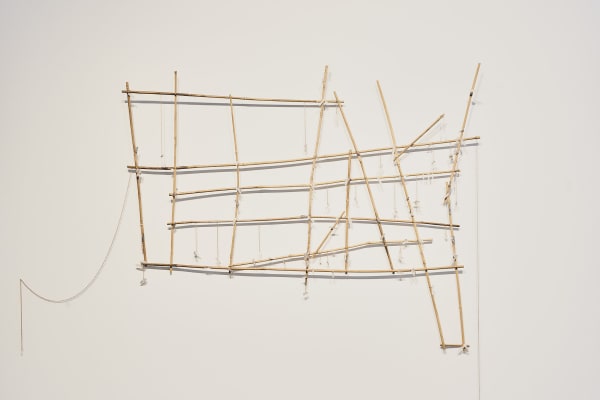Seeking Civilization: Art and Cartography
March 2, 2016 - San Francisco - Gallery Wendi Norris is pleased to present Seeking Civilization: Art and Cartography, a group exhibition featuring San Francisco-based or represented artists Michael Arcega, Val Britton, Guillermo Galindo, Taraneh Hemami, Omar Mismar, Miguel Angel Ríos and Adrien Segal. Expanding on Robert Storr's seminal 1994 exhibition, Mapping, at the Museum of Modern Art, New York, which highlighted works by Ríos, Seeking Civilization: Art and Cartography offers a timely re-contextualization of the cartographic narrative in contemporary art and the politics of wayfinding.
Including works ranging from deconstructed colonial maps to neon light installations documenting personal journeys in search of love, featured artworks investigate and reflect on nationhood, citizenship, migration, identity politics, evolving cities, climate change, and the relationship between freedom and borders. Curated in the same anthological style as the original 1994 MoMA exhibition, Seeking Civilization: Art and Cartography unites work across a wide range of materials and scales, and presents new, never-before-seen contemporary artworks alongside seminal post-colonial works from the 1990's.
Anchoring the exhibition is Miguel Angel Ríos' Le Premier Voyage a L'inconnu, a large-scale Cibachrome print mounted on hand-pleated canvas and attached to the wall using push pins. Completed in 1993 in advance of Mapping, this work deconstructs a reproduction of a map of the "New World" originally made by Christopher Columbus' expedition team. Intended to strip away the power of the map as a utilitarian tool of modernity and colonialism, it repositions the map as a fine art object, free from the order, logic, and functionality implicit to modernism and cartography.
Expanding on maps as tools of wayfinding, Michael Arcega's Prih-Sohn Stick Chart (Map of isolation chambers), 2015, uses bamboo, crystal, and natural fiber to create a map of the locations of the United States prison system's solitary confinement units. The work directly references the Polynesian use of stick charts to map oceanic navigation, while presenting the moral and ethical issues surrounding the criminal justice system. In juxtaposition, is Val Britton's never-before-exhibited 17-foot long Study for Voyage. Originally created as a study for her permanent public commissioned work, Voyage, at the San Francisco International Airport, this work compares and contrasts elements of the airport and its environs that have remained fixed and those elements that are in a constant state of geological or environmental flux.
Further referencing contemporary political issues surrounding migration and national borders, Guillermo Galindo exhibits three newly created sound-scores as maps, printed directly onto faded, weathered flags found at the Mexico-California border. Donated to the project by the humanitarian citizen organization, Water Stations, and printed by Magnolia Editions, these discarded flags were once used to indicate the presence of water tanks for traveling migrants placed in the Calexico desert. Now they depict contemporary music scores by Galindo, that simultaneously reference modernist abstract paintings and document the realities of the life of Latin American migrants.
Iranian-American Taraneh Hemami specifically engages the concept of time and personal migration in her work. Her 66-inch diameter wax and pigment/inkjet print on vellum and paper, Recounting, fuses a classical Persian calendar with a personal travel log. This piece, made over the course of two years, is a document of the artist's lifetime of travel and relocation and is a record of one's search for home, work, representation, citizenship, and community.
Omar Mismar's The Path of Love #03, a 128-inch wide neon installation that takes the shape of the pathways the artist walked throughout San Francisco while on "dates" sourced in the all-male dating app, Grindr. Tied to his relationship with queer identity and the politics of sexual representation in his former home of Beirut, Lebanon, this work looks at the intersectionality of queer rights, geography, love, sex, technology, and ultimately, freedom. With multiple works in his oeuvre referencing human movement and LGBTQ relationships, his work interrogates where, how, with whom and in what contexts a person can express their love.
Adrien Segal presents Grewingk Glacier, an ephemeral data sculpture whose form is determined by mapping the shape of the terminus of Alaska's Grewingk Glacier as it has receded over the last 150 years. By creating a physical form interpreted from aerial maps of the glacier's perimeter data and cast from ice melt collected from the glacier itself, the artist's work interprets how the shape of Grewingk Glacier has changed over time. This melting glacial sculpture is displayed on a custom stone plinth. The cast ice will be shown at various stages of melting throughout the duration of the exhibition. Taking an interdisciplinary approach that integrates scientific research, data visualization, history, landscape, and materiality, this work uses scientific data as a conceptual resource.
PUBLIC PROGRAMMING
The opening reception will feature a special performance by Guillermo Galindo titled Sonic Borders #2, a 15-minute musical performance in which the artist activates his signature instruments made from refuse collected along the US/Mexico border.




